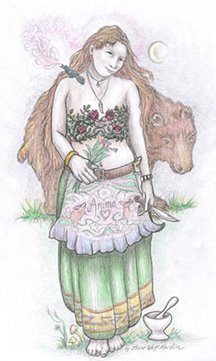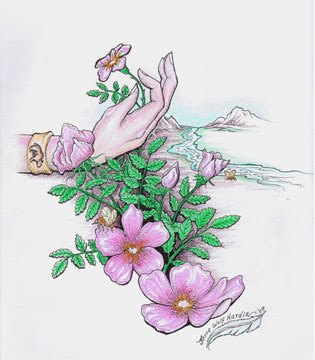 I’m so in love with this plant, I’ve loved it since I was a little girl without even knowing why. Long before I understood the medicine or mythology of Elder, I just knew that I loved to be around her, I’ve even always loved the slightly rank smell of the leaves. When I lived in the NE (the bad old days), I was forever propagating small Elder bushes, much to the dismay of more refined gardeners who couldn’t understand why I insisted on spreading a common weed.
I’m so in love with this plant, I’ve loved it since I was a little girl without even knowing why. Long before I understood the medicine or mythology of Elder, I just knew that I loved to be around her, I’ve even always loved the slightly rank smell of the leaves. When I lived in the NE (the bad old days), I was forever propagating small Elder bushes, much to the dismay of more refined gardeners who couldn’t understand why I insisted on spreading a common weed.
The medicine I make the most copious amounts of is my Elder Mother Elixir, I’ve used it time and time again to ward off an impending virus. I’ve used it to prevent the bug, to ward it off when showing first symptoms and to quicken recovery time once the bug has been fully contracted. This is the way I do it: I make a tincture of dried elderberry with 2 parts brandy, 1 part glycerine and 1 part alcohol. Very simple and very yummy tasting, I find this an easy alternative to syrups (and you or your children won’t run around in a sugar induced ADHD haze after a dose of this either). For good measure, I usually prepare tinctures of rosehips and ginger using the same ratios, then blend 80 percent elderberry with ten percent rosehips and ten percent ginger. For an adult, use one dropperfull every hour and a half to two hours until symptoms disappear. In case you don’t have these tinctures on hand, you can make a decoction or overnight infusion using the same ratio of plants in a quart of water (I use a pint for children 5 and up and haven’t yet used it for children younger than that), taken over a period of some hours, this seems to work great.
I’ve found that for many people, especially sensitive individuals and children, the tincture or tea can give a pleasant sense of calmness accompanied by renewed energy, especially if your feeling run down or overtired. This is why Elder has come to be called an adaptogen by some herbalists (most notably cancer specialist Donald Yance) and its stress reducing capabilities have been tested on jet fighters and the like.
I have experienced no side effects with this herb, it is a gentle and nutritive plant (berries and flowers only please, the leaves and bark are an entirely different matter). I have also observed no problems when used by people with auto-immune diseases as of yet.
Elder is cooling and drying, it has been traditionally used to bring down fevers and it can also help women experiencing hot flashes with menopause. I’m posting below an essay about Elder I wrote for an herbal column that I do for a regional paper that includes more of the mythology etc of the plant.
References:
The Book of Herbal Wisdom by Matthew Wood
Adaptogens: New Conceptions and Uses,Personal Insights and Recent Advances by Donald R. Yance, Jr.
Medicinal Plants of the Mountain West by Michael Moore
Healing Plants of the Rocky Mountains by Darcy Williamson
Herbal Medicine of the American Southwest by Charlie Kane
The New Menopausal Years by Susun Weed
The Complete Women’s Herbal by Anne McIntyre
Elda Mor: The Healing Properties of the Elder Mother
by Kiva Rose
“If the medicinal properties of [Elder] were fully known, I cannot tell what our countryman could ail for which he might not fetch a remedy from every hedge, either for sickness, or wounds.”
- John Evelyn
Common Name: Elder
Botanical Name: Sambucus spp., local variations include Sambucus mexicana and Sambucus neomexicana.
Our five year old daughter, Rhiannon, lays with me under the wide branches of the canyon’s largest Elder tree, watching the Summer Solstice’s full moon through it’s vibrant green leaves and ivory flower clusters that nod in the gentle breeze. We can smell both the bitterness of the leaves and the strangely intoxicating perfume of the flowers, a heady mix that leaves us dreamy but aware. It’s been said for centuries that should a person rest beneath an Elder tree on Midsummer’s Eve that they may be swept away to the enchanted land of Faerie. And once you’ve smelled the evocative but peculiar scent of its creamy clumps of star-shaped flowers, you’ll understand just how transportive Elder can be. Rhiannon has her very own “faery house” here beneath this tree, a little ways downriver from our small homestead, always collecting rose petals, pine-cones and other treasures to nestle among the roots now surrounding us. The native peoples of California called Elder the “tree of music,” and believed that if you listened carefully in the darkest part of the night you would hear the high pitched and wild music of the tree singing, while the ancient Greeks said that the very pipes of the great forest god Pan were made from its hollow stems. But the oldest legends name the tree, Elda-Mor, The Elder Mother who protected and healed her people.
Called the medicine chest of the country people, Elder is gentle enough for children and older folks, but is an impressively powerful plant that can be used for everything from the flu to wounds to nervous tension. Revered by the Gypsies as sacred and inspirited, they showed their respect for its medicine by never burning or cutting any Elder wood. It was also forbidden in much of Europe to chop an elder down or to even break a limb off for any use. When any part of the Elder was taken, permission had to be asked in the form of a simple chant before being allowed to continue. The Mexicans call the tree Flor de Sauz or Capulín de Silvestre and have long known the value of this wonderful remedio. Elder has been esteemed wherever it has grown, used by the Europeans, Native Americans, Egyptian and Arabic people alike. A recipe for an Elderberry syrup called a “rob” was even preserved within the pages of Arabian Nights. Most homestyle herbalists still count Elder among their most valuable allies in healing all sorts of illnesses and ailments. So innumerable are the uses of this amazine plant that no one book or teacher can tell all them, and it’s a lifetime study coming to fully understand the extent of its healing properties. Perhaps the simplest way to begin your association with this plant is through an old-fashioned elderberry syrup. Thick and and sweet and wild-tasting, this deep purple treat compliments even the finest pancakes but also delivers a good dose of powerful medicine, especially if made with raw honey.
A simple but effective recipe for Elderberry syrup is to place one ounce dried elderberries in a quart canning jar, fill to top with boiling water. Cover, and let steep overnight, or for 6 to 8 hours. Then strain, reserving liquid and heat two cups of the liquid over low heat, never allowing it to boil, until you are left with one cup. Add enough raw honey to sweeten and thicken the syrup to desired consistency, then add a teaspoon or two of good brandy to help preserve the syrup. Pour into a pretty glass bottle and keep nearby to fend of any sniffles, fevers or tummyaches.
Yummy variations include adding a handful of dried rose hips to the jar before filling with water for extra taste and Vitamin C content, or adding some grated fresh ginger (or chopped candied ginger) during the heating process to make a spicier, warmer syrup. I also love a hot cup of elderberry tea, a wonderful brew just for its pleasurable taste, but Elderflowers and berries are also wonderful as a vinegar, a brandy, steeped in honey or as a homemade wine.
A plant varying in stature from a small shrub to a sizable tree, Elder can be found in nearly every region of the United States. And while definitely a water loving plant, it thrives even here in the often arid Southwest. Huge Mexican Elders grace the Tanque Verde wash and other areas in the Sonoran Desert of Arizona while smaller New Mexico Elders grow near wild roses, ponderosa pine and alligator juniper in our own riparian Gila canyons. Look for Elders set back from river banks and arroyo walls, usually near roses and conifers. The parts most commonly and safely used internally for medicine are the flower and berries, available for gathering in the Southwest from about June to September. Do make sure you only gather from the trees with blue or black berries, as the red berried variant has been known to cause severe stomach pain. The leaves are effective and safe when used externally and can be gathered the entire growing season. If you’re unable to find an Elder tree near you, Silver City is blessed to have two herb stores, Desert Bloom Herbs and Bear Creek Herbs, which will be happy to supply you with the berries and flowers of this amazing plant year round.
Elder has also long been considered an invaluable aid to longevity, encouraging overall health and protecting the body from many of the detrimental effects of aging through it’s ability as an incredibly effective anti-oxidant. Elder has potent free-radical scavenging ability and provides widespread cellular protection. This results in increased resistance to vascular disease, cancer and cataracts. Elderberry has also been shown to reduce LDL cholesterol and atherosclerosis, helping reverse damage that’s already been done while guarding against future problems.
Elder is also a powerful yet nearly unrecognized adaptogen. Popular adaptogenic herbs such as ginseng, rhodeola root and schizandra, and are well touted by the media for their energizing and protective benefits for the whole body. Yet these adaptogens are all either imported from far away countries or very rare, and therefore very expensive. Elder is so common as to be called a weed in several parts of North America. Easily accessible, it’s free to gather or cheap to buy just about anywhere you go. Adaptogens are plants that assist our bodies achieving peak physical performance at all times by increasing energy and work capacity under normal conditions. When our bodies are under stress due to sickness, stress or environmental factors, adaptogens help us by activating the organism's systems, protecting the body from damage (especially, stress induced damage) and also stimulating regeneration and repair. Austrian research on Elderberry shows it to possess remarkable stress-reducing ability. In one study, Elderberry shortened recovery time from physical exertion. In another study conducted by the US Air Force, Elderberry extract significantly reduced the stress load endured by pilots. In addition to helping the body deal with stress, Elder also offers a gentle but impressive effect on the nervous system, calming upset nerves and helping to instill a deep sense of peace. I especially like to combine Elder with Rose for the best results in lifting the spirits for an overall feeling of well-being.
Elder is also a non-specific immune enhancer, containing a unique protein that acts as a messenger to help regulate immune response. This means that unlike simple immune stimulants such as Echinacea that can wear down the body’s immune system by overstimulating its defenses, Elder helps the body know when to fight and when to rest, resulting in a more effective and efficient defense against viruses and other illnesses. And I’ve had great success when taking elderberry syrup myself or giving it to family and friend to fend off cold and flu bugs, making it my number one choice for immune enhancement and viral protection. Powerfully active against at least fourteen strains of flu (including the infamous Avian Flu), as well as Herpes Simplex virus I and II, HIV and Epstein-Barr. Well researched in Austria, Switzerland and Israel, Elderberry has just recently begun to be recognized in modern medicine for what folk medicine has known all along. In extensive tests, Elderberry was shown to reduce recovery time from flu by a full half and lessens symptoms almost immediately. It effectively soothes coughs, calms stomachaches and lessens headaches. And it’s so tasty that you won’t have to try very hard to convince your little ones to take their medicine.
The berries and flowers both protect the liver from damaging chemicals and other malignant influences, this important property combined with Elder’s powerful antiviral properties and it’s ability to heal damaged tissue could be potentially crucial for those living with viral Hepatitis. An herbal diuretic that both replenishes the body’s potassium supply and acts as a urinary disinfectant, Elder tones the mucous linings of the body, helping to prevent infection in susceptible areas such as the respiratory tract and urinary tract. Because of this protection for the respiratory tract as well as it’s ability to act as a systemic decongestant for uric acid and other wastes that can cause allergies and arthritis, it has been traditionally used as a preventive measure as well as a treatment for the symptoms of allergies and arthritis.
The leaves or flowers can effectively be used as a poultice or bath for swellings, sprains, burns or any inflammation or infection. My favorite all-purpose salve is made with fresh elder leaves steeped in olive oil and then blended with honey scented beeswax. For centuries women have soaked the flowers in water or buttermilk and used it as a lotion to refine the complexion and tone the skin. Such a multi-purpose herb surely deserves a place in every household, and I always keep a bag of berries and flowers on hand for a variety of uses.
Just as Rhiannon is slipping off into dreamland, we hear the echo of an owl hoot, the yip of a single coyote and the sudden surge of frog songs down by the river. The flute-like melody of the Canyon winds weave in and out of our woodland bed, and by the smile on Rhiannon’s face I can see she, too, hears the sweet lullaby of the Elder Mother.
Tuesday, January 9, 2007
The Elder Mother
Posted by
Oakmoss Changeling
at
9:47 AM
![]()
Labels: Medicine Woman Materia Medica
Subscribe to:
Post Comments (Atom)
The Medicine Woman is glad you came...
All writings & posts (c)2007 Kiva Rose
All artwork & photographs (c) 2007 Jesse Wolf Hardin












No comments:
Post a Comment